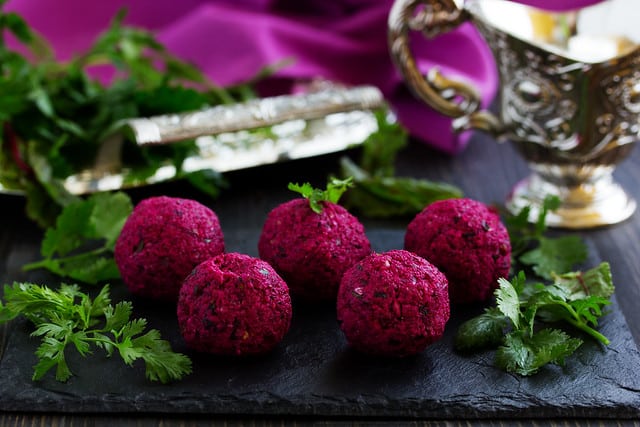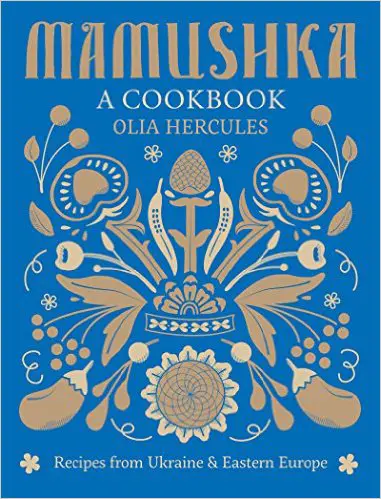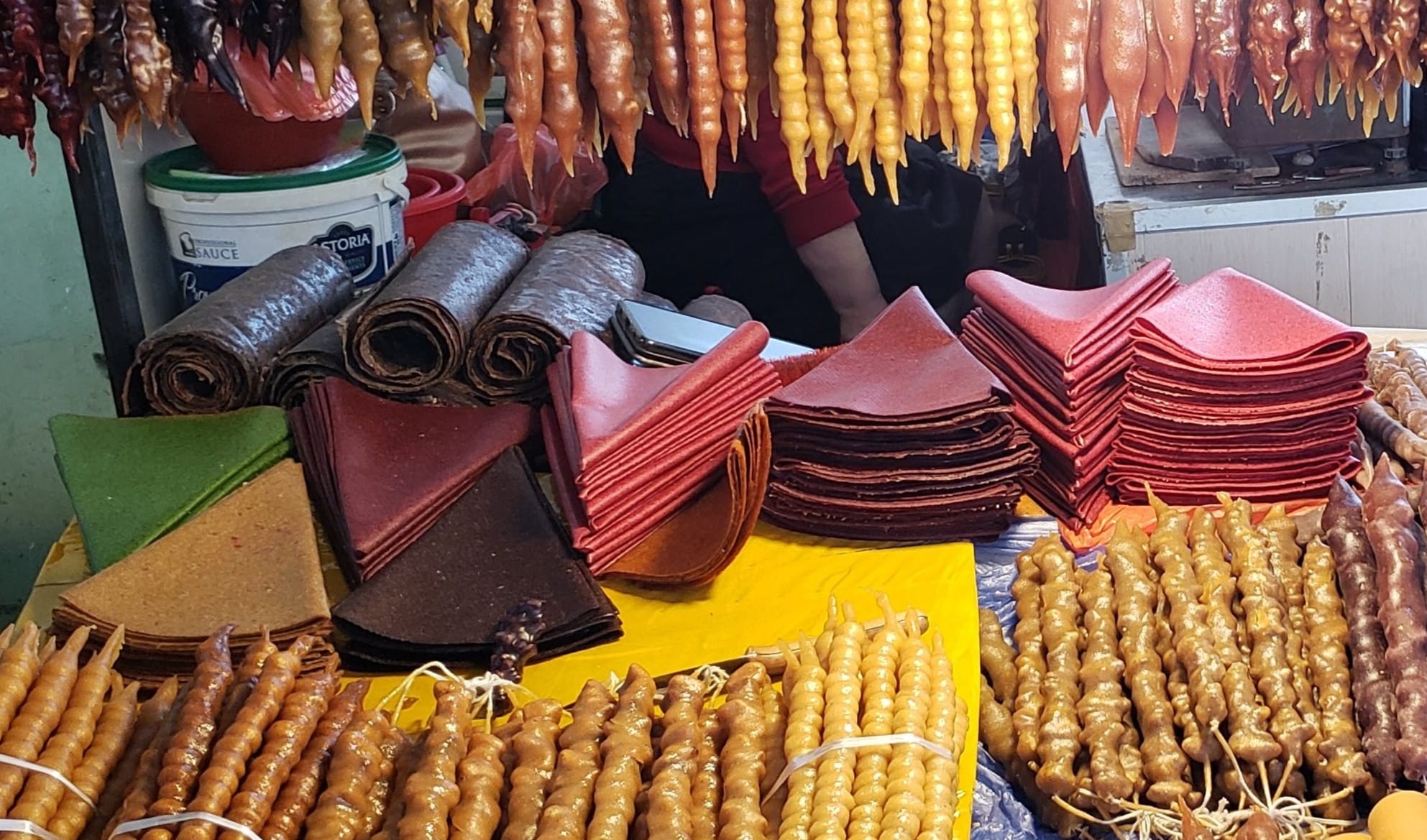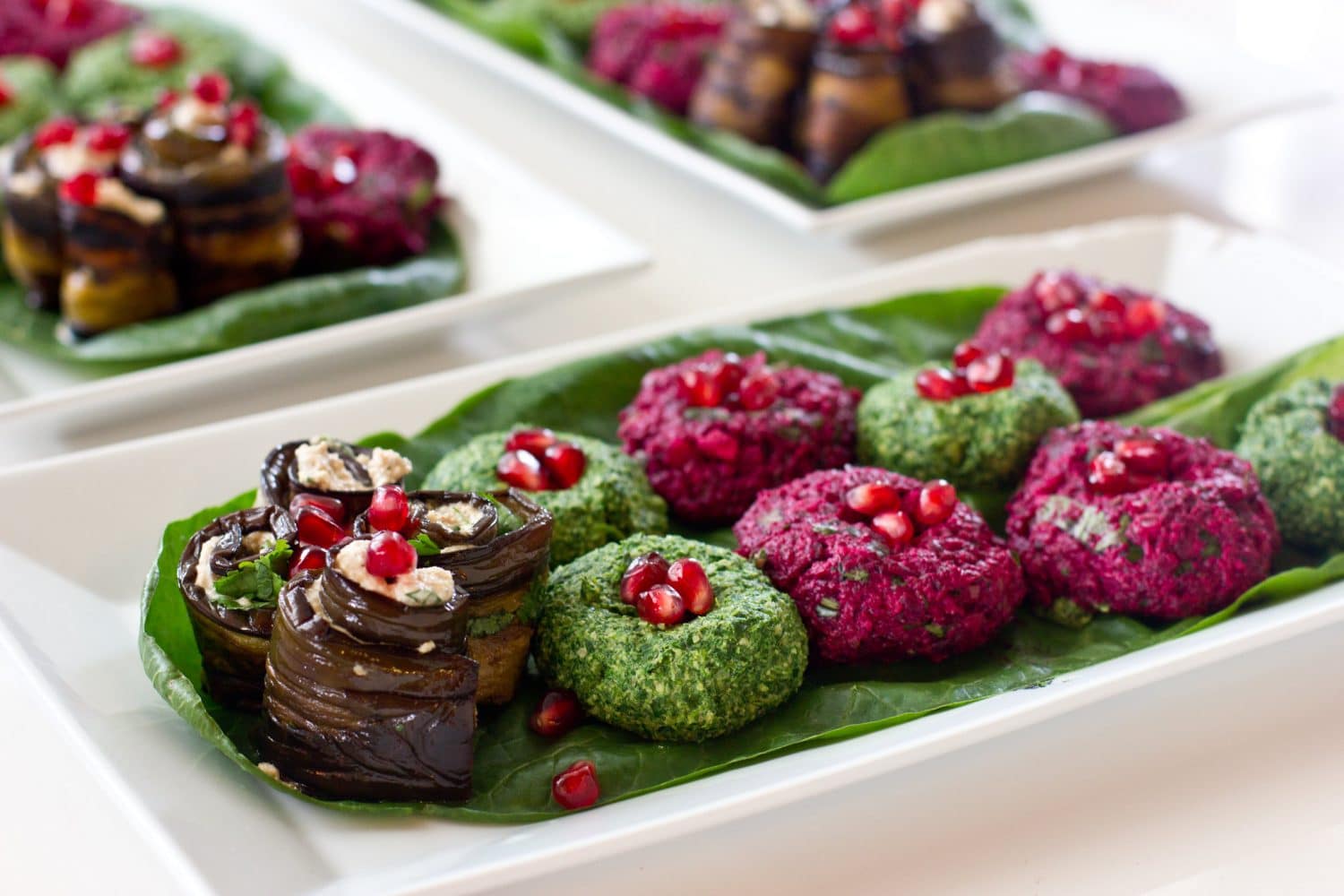Pkhali (пхали in Russian; ფხალიin in Georgian), made from finely chopped and cooked vegetables mixed with spicy walnut sauce, is one of the most popular traditional Georgian dishes. It is usually garnished with pomegranate seeds and sometimes served alongside eggplant rolls that also feature spicy walnut filling.
Almost any vegetable can be used to make pkhali, meaning that there are hundreds of variations of this dish. The most common are made from spinach, beets, or green beans. With its creaminess from the walnut sauce; a tart, tangy flavor from the vinegar; and a kick from the spices, pkhali is known and eaten throughout the former Soviet Union and beyond.
Why It’s Called “Pkhali”
(Почему так называется?)
Pkhali has no modern meaning beyond the name of the food. It is often translated as “pâté,” however, as the two foods have similar features.
The dish is sometimes referred to as mkhali, apparently because some restaurants in Georgia began listing the food that way on their menus because so many of their 19th century Russian customers mispronounced the name in this manner. Fkhali is another common variant, which is actually close to the Georgian original, which does actually begin with “ფ” – a Georgian letter pronounced like “f.” The more percussive “pkhali,” however, is the most standard version used in English and Russian alike.
It is interesting to note that quite a few of Georgian vocabulary for food has a -li suffix, for example, oranges are portokhali (ფორთოხალი), apples are vashli (ვაშლი), and dinner is sadili (სადილი).

How and When to Eat Pkhali
(Как правильно есть пхали?)
Pkhali is a relatively inexpensive and highly nutritious food that can be found on Georgian tables year round. For holidays and special events, multiple types of pkhali are served, bringing additional bright colors and distinct flavors to the meal.
Pkhali is often eaten as a spread for “мчади” (mchadi or Georgian corn cakes) or “дедас пури” (deda’s puri оr flatbread), alongside fresh herbs and cheese. It is also common to have pkhali on its own and indulge in the delightful and refreshing flavors it has to offer.
In addition to its deliciousness, pkhali is known for being a healthy dish as it is mostly made from vegetables. The benefits vary, depending on the type of greens, for example the spinach pkhali is said to strengthen the immune system and lower blood pressure.
How to Prepare Pkhali
(Как правильно готовить пхали?)
Pkhali, like many dishes in Georgian cuisine is a single type of dish with many different recipes and a range of ingredients that can be used. Many chefs will have their own family variations and twists on the dish. Different spices are used based on what vegetable is used as the base. It should also be mentioned that, while much rarer, meat versions of this dish, often with poultry as the base, do exist as well. The most important mainstay of the dish is the thick, seasoned walnut paste that holds the dish together and allows it to be presented in a neat, molded shape.
Preparing pkhali is a fairly simple process. However, most chefs will agree that the various steps should not be mixed. The paste is typically using a food processor or grinding bowl. The main ingredient, vegetable or meat, will be finally chopped or run through a food processor. The two are then mixed by hand. This gives the dish two different textures, preventing it from becoming a homogenous paste.
In addition, pkhali should be allowed to rest for at least six hours so that all the various flavors can meld. This makes it particularly good for festive occasions, as it is a dish that can be made the day before. Pkhali is always served at room temperature.
Most Georgian recipes will call for specific spices, which are common in Georgia and essential in making Georgian foods specifically Georgian. Most are also now easily available online. We’ve provided links to Amazon suppliers in the recipes where available. Some, such as Georgian saffron, are harder to find. Georgian saffron comes from a breed of marigold flower that grows in Georgian which has very similar properties to saffron. You may replace this with regular saffron.
For presentation, rolling the product into a slightly flattened palm-sized ball and garnishing with 1-3 pomegranate seeds placed on top is most common. However, there is no one, fixed appearance to pkhali. Presenting it in a geometric shape, however, is generally preferred (i.e. triangles or squares).
“Рулетиками из обжаренных баклажанов” (eggplant rolls) are often served with pkhali. These use the same walnut paste as pkhali, but rather than adding ground or chopped eggplant, the eggplant is wrapped around the paste. Thus, these can be considered in the same family as pkhali and are often served on the same plate even though they are not known as pkhali.
Let’s Cook!
(Давай приготовим!)
See below for a free recipe for pkhali. See also the free videos online. If you are interested in cooking from Russia, Ukraine, Georgia, and other places in Eurasia, make sure to see our full, free Eurasian Cookbook online! You might also be interested in the following specialized cookbooks we’ve enjoyed:
 |
 |
 |
 |
| Пхали (из шпината) | Spinach Pkhali |
Ингредиенты:
Приготовление: 1. Шпинат тщательно промыть, залить кипятком и варить 1 мин. Откинуть на дуршлаг и отжать. 2. Кинзу промыть и измельчить. Лук и чеснок очистить, измельчить. Поместить в блендер вместе с орехами, кинзой, специями, солью и перцем. Размолоть в однородную массу. 3. Пропустить шпинат через мясорубку и смешать с ореховой заправкой. Добавить 2 капли уксуса. Скатать из полученной массы шарики, выложить на блюдо. Можно подать с зеленью или украсить зернами граната. |
Ingredients:
Preparation: 1. Thoroughly wash the spinach, then pour boiling water over it and let it sit for 1 minute. Throw the spinach into a colander and squeeze the water out. 2. Wash and chop the cilantro. Peel and chop the onions and garlic. Put these in a blender with the nuts, cilantro, spices, and salt and pepper. Blend the mixture until it becomes homogenous. 3. Put the spinach through the meat grinder, then mix it with the nut dressing. Add two drops of vinegar. Roll the mixture into balls and put them on a plate. Can be served with greens or pomegranate seeds.
|
| Пхали (из свеклы) | Beetroot Pkhali |
Ингредиенты:
Приготовление: 1. В кипящую, подсоленную воду кладем свеклу и немного пищевой соды. 2. Вынимаем свеклу из воды и руками стараемся выжать сок. Оставшуюся воду сливаем. 3. Через мелкую мясорубку несколько раз прокрутить грецкий орех и чеснок. 4. Смесь ореха и чеснока добавить к мелко порубленной свекле. 5. На сковороде обжариваем лук и добавляем к нему получившуюся массу. 6. Добавляем специи и зелень. 7. Добавляем уксус и еще раз перемешиваем. 8. Лепим шарики. |
Ingredients:
Preparation: 1. Put the beetroots and some baking soda in boiling salted water. 2. (When done) take the beetroots out of the water (chop them finely) and squeeze the juice out by hand. Drain the remaining water. 3. Put the walnuts and garlic through the meat grinder a few times 4. Add a mixture of walnuts and garlic to the finely chopped beetroots. 5. Fry the onion in a pan and add the resulting mixture to the mixture. 6. Add spices and herbs 7. Add vinegar and mix it again. 8. Mold into balls
|
| Рулетики из баклажанов (с грецкими орехами | Eggplant Rolls (with walnuts) |
Ингредиенты:
Приготовление: 1. Баклажаны нарезать вдоль тонкими пластинами толщиной 3-5 мм, посолить и оставить на 10 минут. Отжать, промыть и обсушить. 2. На сковороде разогреть растительное масло и обжарить баклажаны с двух сторон до золотистой корочки. Обжаренные пластины баклажанов выложить на бумажные салфетки, чтобы избавиться от излишков масла. 3. Грецкие орехи измельчить с помощью блендера или кухонного комбайна и смешать с пропущенным через пресс чесноком. (Если ты используешь помидор, то нарежь его мелко и добавь к начинке.) 4. На каждую пластину баклажана выложить по одной чайной ложке начинки и свернуть ее в рулетик. Готовые рулетики выложить на блюдо и украсить зеленью. |
Ingredients:
Preparation: 1. Cut eggplants lengthwise into 3-5 mm-thick slices, add salt, and leave for 10 minutes. Wring out, rinse, and dry. 2. Heat the vegetable oil in a pan and fry the eggplants on both sides until golden brown. Put the fried eggplants on a paper towel to get rid of excess oil. 3. Grind walnuts with a blender or food processor and mix them with pressed garlic. (If you use a tomato, chop it finely and add to the filling.) 4. Spread one teaspoonful of the filling on each slice of eggplant and fold it into a roll. Put the finished rolls on a dish and decorate it with greens.
|
Our Favorite Pkhali Videos
This video is created by a YouTuber called “Покашеварим” (Pokashevarim) whose channel is entirely about food (the name basically means “while we make kasha”). In this video, he shows us step-by-step how to make both spinach and beetroot pkhali, while making eggplant rolls at the same time.
As part of a popular series “Осамомглавном” (About the Most Important) by Russia Channel (one of Russia’s most watched TV networks), this video discusses the health benefits of a spinach pkhali while showing us how to cook it. The video is entertaining with fun hosts and music in the background.
https://www.youtube.com/watch?v=ostl7sSfkME
You Might Also Like
What shapes Georgian national identity? The answer is complex and personal, but one key element is the Georgian national narrative. This includes the heroes and pivotal events taught in schools, the places central to the nation’s collective memory, and the language and beliefs that frame its worldview. A national narrative goes beyond history: it is […] The Talking Phrasebook Series presents useful phrases and words in side-by-side translation and with audio files specifically geared to help students work on listening skills and pronunciation. Each entry below, divided by category, features an English word or phrase in the left column and its Georgian translation in the right. The Georgian is presented in […] Georgian holidays strongly reflect the country’s unique traditions and its demographics. First, as more than 80% of Georgians identify with the Georgian Orthodox Church, the strong influence of the church can be felt in the preponderance of Orthodox holidays. Georgia also has several holidays celebrating its statehood and independence, which have been hard-won. We can […] Fruit leather is simple, ancient food. Like bread and roasted meat, it likely independently evolved in several places. At its most basic, it is simply mashed fruit smeared to a sheet and left to dry in the sun. The result is a flavor-intensive food that travels well and can keep for months. The oldest known […] This guide to travel in Georgia is tailored for Jewish-American university students preparing to study abroad in Georgia. We navigate the historical depth and modern vibrancy of Jewish life in this culturally rich country. Discover key historical sites, engage with local Jewish communities, and find practical tips on maintaining kosher practices and observing Shabbat while […]
Georgia’s Story of Identity: Heroes, Memory, and Meaning

The Talking Georgian Phrasebook

Georgian Holidays 2026: A Complete Guide

Tklapi, Pastegh, Lavashak: One Ingredient Fruit Leather from the Caucasus

Jewish Georgia: A Brief History and Guide





